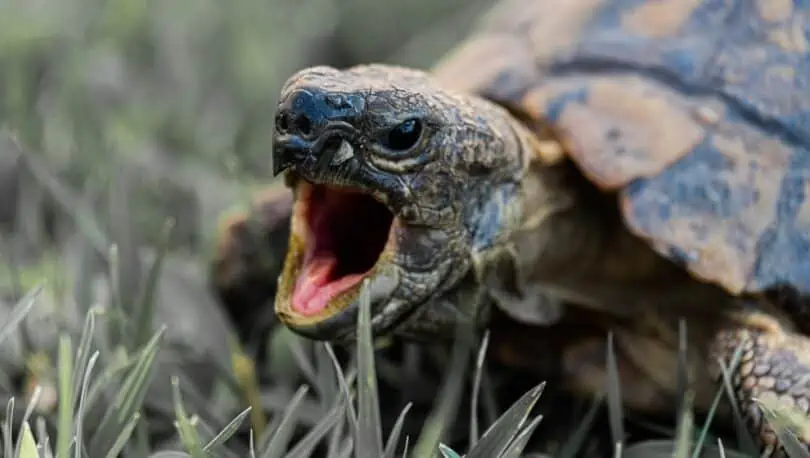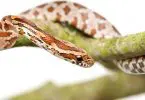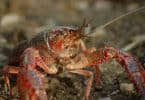Turtles, like all other animals, have innate defense mechanisms. Among these, the first line is hissing and then attacking, which includes primarily biting. As pet turtles seem to be relying on you for most of their needs, they can mark you as a threat.
Moreover, usually, animals considered large bodied creatures as their predators. The same goes for turtles. So, it is no surprise why your turtle is biting you.
However, now the question is, can you really train a turtle not to bit? Well, the answer is yes. You can actually train your turtle for multiple tricks too. For detailed information on training your turtle, you may link to our article on How to train your turtle to do tricks?
So, you can also train your turtle for certain behaviors and good habits. Also, turtles are smart enough to understand the training process. However, the progress usually is slower than your furry pet fellows; it is still worth all the efforts. Your turtle is going to live with you for decades. So, are you ready for a few weeks and months of consistency in your efforts to train your turtle for not biting?
If yes, read the article till the very end. We have discussed the reasons for turtles biting, tips and tricks for turtles training, and all you need to know about biting behavior in turtles.
Table of Contents
Reasons For Turtle's Bitting
Turtles usually bite because of irritation or in fear of getting attacked. This process is quite common in most reptiles. If you are moving your finger continuously around your pet turtles, they will bite you in reaction.
Irritation
When the turtle is irritated, it might become over-reactive to everything approaching it.
The behavior is prevalent when the turtle starts shedding its scutes. It is because not only is the creature undergoing a complex process, but also its body is now more vulnerable. Therefore, the best idea is to leave your turtle alone during this time and let it ultimately return to its standard physical form.
Another common reason behind unexplained irritation is mating season. Not only the females but also males become overly defensive, irritated, and overpowering during the whole season. So, let your pet complete its breeding in peace to avoid any undesired response.
The Feeling Of Threat
The feeling of the threat is one of the essential reasons behind biting in turtles. As mentioned before, turtles usually think of large-bodied creatures as predators. Think of yourself being approached by someone who is 100x larger than you, can tap your head, and can completely control your motions. Seem horrible, right.
This well explains the situation of your turtle when you approach it. However, if you successfully develop an amicable relationship with your pet and your turtle is sure that it posses no harm from you, it will avoid the defensive attack. Mostly this behavior is more common in newly brought turtles.
Hunger
If you go negligent in feeding your turtle correctly on time, or it may bite you if the food is not enough. Well, there can be two reasons. First, you are the only food source for your pet, so that it might be aggression or a reminder for you. Second, it might take you like food and try to bite your finger off.
So, the best way to avoid this is to feed it on time and make a proper diet chart for your turtle.
Misunderstanding Food For Finger
Another common reason your turtles biting comes when you are hand feeding your turtle. Turtle gets the scent of food from your finger and can not distinguish between the two. So, you see, it is not any kind of aggressive behavior, just a slight innocent misunderstanding.
Seeing A Stranger
Turtles are really shy fellows. They are not very habitual of meeting random people with a smile on their faces. So, if your friend visits you and tries to approach your turtle in its tank, it might consider it an invader.
The biting response is more of a defensive behavior than of any other cause.
Once you are well aware of all the possible reasons for biting by turtles, let’s progress to training tips and tricks you can easily follow to train your turtle not to bite.
Tips And Tricks For Training Turtles Not To Bite
One must think that training a turtle is quite a complex process. Still, according to my experience, it is pretty simple and interesting. Seeing your turtle getting into a new routine or adopting a new habit is really exciting to experience.
Yeah, training turtles is a slow and steady process. It requires a lot of patience. The training process may require days to weeks or months or maybe years.
Moreover, the progress report somehow depends upon the species or the age of the turtle. However, you can train any turtles species to stop biting by working on the following simple tips and tricks I personally rely on:
Offering Them Food (Directly By Your Hands)
You can train your turtle by giving them treats/foods directly from your hand. In this way, they will be able to memorize and relate your fingers with food. Turtles will soon get used to it and will not bite your finger.
By Physical Gestures
You can also train your pet turtles by showing some physical gestures. These can be:
Showing Palm
Showing turtles your palm will indicate them to stop doing something or something is inappropriate. This can be done whenever turtles are super excited/out of control.
Showing Finger
Pointing your finger towards them also indicates the turtles to stop.
Introducing Turtles To Your Friends
If you are introducing your turtles to your friends, try to do it slowly. This will increase the chance of threat to the turtle resulting in a bite. First, try to make the turtle’s eye contact with the stranger for some time. In this way, your pet turtle will be able to recognize the person.
Slowly building up the trust of the turtle is the best way. Start playing with it. You will see after some time and the turtle starts getting comfortable with your friend (a stranger to him). Time taken for this bonding is different for different species. It may take several days to even a year. You just need to be patient with the cute little pet and give its time to feel confident about its new fellow.
Make Them Recognize You
Turtles are anti-social animals, and they don’t need/make friends. However, turtles can make a strong bond with their owners. They can recognize you and your voice. Both you and your cute little turtle can share a good friendship bond. You simply need to make them used to you.
Try to pick the turtle in a single move. Pat your pet turtle’s shell, or you can just rub a toothbrush if you are afraid of a turtle. In this way, your turtle will get attached to you and will not bite.
What To Do After A Turtle Bite?
If your turtle has bitten you, just relax. It is not a matter of emergency. It is because usually, the bite is not harsh as turtles don’t have teeth or strong jaws. They simply try to bite with their beaks. Wash the area with water.
If you have minor bruises, you may clean the area with an alcohol swab. You can then apply the anti-biotic cream or any ointment if necessary. The pain is uncommon. You might take acetaminophen or any other OTC analgesic. Consult a doctor in the case of increasing pain.
Steps That Will Lower The Risk Of Turtle's Biting
In addition to training, you can also take the following measures to prevent turtle biting:
Maintaining A Proper Habitat
Turtles are usually semi-aquatic organisms and like to swim in the water. If you are adopting turtles, you must keep a tank of large surfaces for their proper swimming. Unavailability of such habitat will lead to turtle’s mood swings and increase the chances of irritation resulting in a bite.
Separate Tank For Food
Another idea is that you can also prepare a separate tank for them to eat. You have to partially fill it will water and drop some of the treats in it. Shifting the turtle a few times for eating will make them remember it. So your pet turtles will get excited when you pick them as they know you will feed them. This process also lowers the risk of biting.
Biting Among The Partner Turtles
Biting is also significant between the turtles as well. Turtles can bite their partners in the tank. This happens due to the following reasons:
Small Tanks
As it is discussed above that, they require large tanks.
They will bite their friend turtles out of irritation and frustration. Small tanks and a larger number of turtles will lead to overcrowding. In this way, turtles feel threatened, and there is a probability of biting each other.
A Part Of Mating
Male Bites
Mating of turtles also includes biting. Usually, the male turtle approaches the female and tickles or bites her until she allows.
Female Bites
When a male approaches the female and tickles her if she is interested, she will allow him. But if the female turtle lack interest, she will, in turn, bite the male turtle.
Environmental/Habitat Issues
Biting among turtles can also occur because of increased stress, temperature, or any change in the environment.
One important/main reason for stress is the overloading of physical exercise. This happens when you are trying to train your turtles quickly. Training requires time. It cannot be done in a day or two. It would be best if you had to be patient with them.
Having Turtles Of The Same Gender
It is not a good idea to keep two male turtles together. Male turtles are aggressive, so they’ll usually fight. One best option is to keep the turtles of the opposite gender together.
Territorial Disputes
Turtles also bite because of territorial disputes.
Showing Dominance
Turtles also bite among themselves to show dominance. They bite and sometimes flutter their claws in front of other males showing their high status. Usually, a male turtle bites to show male breeding behavior.
Turtles Biting Rocks
Turtles can also bite a rock that is kept near to it. This indicates that your turtle lacks a calcium-rich diet. The solution to this condition can be stated as:
Take your turtle either in the outside open area for basking or provide UVB light from any source. UVB is responsible for maintaining the calcium balance. In this way, rock biting can be controlled.
Precautionary Measures To Prevent Biting Turtles
Bigger Habitat
All these problems have one solution in common: to provide the proper habitat with larger tanks. In this way, the majority of the biting problems can be solved.
Sufficient Food
Give your pet turtles sufficient and good quality food.
Separate Living Space
One best idea is to keep turtles of opposite genders. But you can also keep turtles of the same gender. It is not prohibited.
Conclusion
You see, turtle biting is not always an aggressive behavior. You can efficiently train them to avoid it by following simple steps that can become your routine. Also, the training process will strengthen your bond with your pet.
I hope this article helped you find your way to training your turtle. In case of any query, you may comment below. We would be happy to help.








